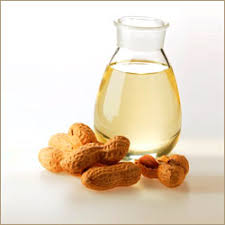Groundnut oil production in India is financially a profitable venture with huge export potential. Groundnut oil processing manufacturing operation can be initiated as small and medium scale basis according to the desired output and project cost. Initiating a groundnut oil production business requires feasibility study preparation, procurement and installation of machines in the appropriate accommodation, recruitment of personnel and project commercial take-off. One metric ton of groundnut seed produces an average of 420 LTR of groundnut oil, 420Kg of groundnut cake, and 40Kg of groundnut sludge.
GROUNDNUT OIL PRODUCTION MARKET POTENTIAL
Groundnuts are a popular source of food throughout the world. Groundnut oil is used for cooking food and as a shortening or as a base for confectioneries and they can be used to make peanut butter. Groundnut oil ranks at the top among edible oils exported from India. It is a premium oil and its cost is also high. Most other edible oils are priced lower than groundnut oil. Groundnut oil is available in the market in refined and filtered forms. Although filtered oils are nutritionally superior in quality.
The size of the global groundnut oil market is about 188,000 MT, during FY2013, about 16,500 MT of groundnut was exported from India. With liberal export policies and a good domestic crop, exports are expected to exceed 25,000 MT in FY 2015.
GROUNDNUT OIL PRODUCTION LICENSE & REGISTRATION
In establishing a groundnut oil production unit, you will need to obtain several different license and registration from different Government authority.
1. Company Registration with ROC
2. Trade License
3. SSI Registration
4. Factory License
5. Food Operator License from fssai
6. BIS Certification
7. ‘No Objection’ from Pollution Control Board
8. AGMARK Certification
9. Fire License
The Food Standards and Safety Rules, 2011, and rules made under IS 544: 1968 permit additions of antioxidants in groundnut oil for a higher shelf life of the oil. However, under the scheme of labeling of environment-friendly products, the presence of antioxidants within a prescribed limit is a requirement as per notification of the Ministry of Environment and Forests. These are the common license and certification requirement. Check with your local DIC authority about any other required formalities.
FINANCE FOR GROUNDNUT OIL PRODUCTION UNIT
Alike any manufacturing industry groundnut oil production business also involves two types of cost factors. One is fixed capital and another one is working capital. A refinance scheme facility is available with NABARD. For fixed capital, you will need to apply term loan or mortgage loan. For working capital requirement, you can go for cash credit or the over draft facility with your nearby bank or any financial institution.
Groundnut Oil Production Unit Setup & Machinery
Selecting a right location for factory operation is an important aspect. Major required utilities are water and electricity. Easy availability of transport facility and labour is important. Create a floor plan indicating specific space for raw material storage, finished products storage, production unit area, administrative work space, store room for oil cakes and space for miscellaneous usage. Generally, 0.50 acre of nonagricultural land is recommended for establishing an improved groundnut oil expelling unit having an installed processing capacity of 240 MT /annum. The land should be with proper elevation.
Machinery required as follows:
1. Pre-cleaner for cleaning the oil seeds
2. Cans and trays for handling oil seeds
3. Batch type solar dryer
4. Tapering screw types mechanical oil expeller
5. Filter press
6. Steel drums for storing edible oil and sedimentation of impurities
7. Weighing balance
8. Semiautomatic bottle filling machine
9. Molded polycarbonate bottle capping cum sealing machine
If you want to go for pouch packing, then automatic pouch filling and sealing machine are required.
RAW MATERIAL FOR GROUNDNUT OIL PRODUCTION
The principal raw material required for the production of groundnut oil is groundnut seed, which can be procured locally. The seed gives 44.5-50% oil, 50-55% meal. Other required raw materials are caustic soda, bleaching earth and packaging consumables.
GROUNDNUT OIL PRODUCTION PROCESS & TECHNOLOGY
Edible oil technology can be grouped into two: mechanical pressing and solvent extraction. For oilseeds with high oil content such as groundnut, first mechanical pressing will be applied and over 85% of the oil will be extracted. The remaining oil in the expeller cake will then be extracted with a solvent. Groundnut oil production process, based on mechanical pressing technology, can be grouped into three stages: seed preparation, pressing and crude oil refining.
Storage → Cleaning → Dehulling → Grinding or rolling → Heating → Pressing oil cakes → Refining impurities → Purified Edible Oil
1. Cleaning
The first step in preparing oil seeds for oil extraction is to clean them. Cleaning is done so that the oil is not contaminated with foreign materials and that the extraction process can proceed as efficiently as possible. During the process inspection of the seeds is carefully done to remove stones, sand, dirt and spoilt seeds. Dry screening technique is often used to remove all material that is over or undersized. Sometimes washing is also resorted to but it must be avoided as the plant tissue will have to be dried at a later stage.
2. Dehulling
During the process, the outer seed coat of the oil seed is removed. A power operated dehuller is generally used for the operation. Removal of the outer seed coat is necessary as it does not contain oil and inclusion of it in the unit operations makes the oil extraction process less efficient. Some seeds such as groundnut can be shelled by hand. Some other such as sunflower seeds are usually hulled in machines. Still others, like safflower and colza, cannot be shelled.
3. Grinding or rolling
Seed is not usually pressed whole since oil extraction is more efficient if the seed is in smaller particles. Herein lies the relevance of the grinding process. Grinding is the process for reducing the particle size. Small motor powered hammer mills are used for the unit operation. Another alternate process used for reduction of particle size is rolling the oilseeds to produce flakes for oil extraction. Many large-scale commercial plants find this the most effective approach. With large oilseeds, it may be necessary to grind the seed first, and then put the pieces through the flaking rollers.
4. Heating
It is the final step for preparing the raw material for oil extraction. Heating leads to increased oil yield. Heating helps in killing those enzymes present in the plant tissue which have a deteriorating effect on oil quality. Moreover, if oilseed cake is to be used for feed or feed, heating is useful as it increases protein availability. Sometimes oil bearing material is pressed without being heated. Oil extracted in this way is called cold press oil.
5. Pressing
During processing, the conditioned oil seeds/ oil bearing material is pressed using a lever press, hydraulic press or a mechanical expeller to remove the oil.
6. Refining
The process is used when the lower quality feedstock is used for oil extraction. It helps in removing undesirable cloudiness, color, and flavor from the extracted oil.
In groundnut oil production, mentioning the shelf life on packets or labels is mandatory.


